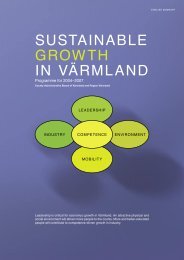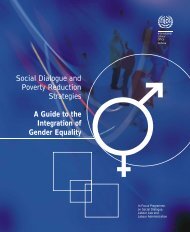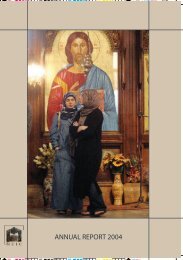PDF (222 KB) - Document Database website
PDF (222 KB) - Document Database website
PDF (222 KB) - Document Database website
Create successful ePaper yourself
Turn your PDF publications into a flip-book with our unique Google optimized e-Paper software.
ACHIEVING THE LISBON GOALS<br />
THE CONTRIBUTION OF VOCATIONAL EDUCATION AND TRAINING IN ROMANIA<br />
<br />
10 years, and there are currently two<br />
pathways of compulsory education at<br />
the end of the eighth grade: the lower<br />
cycle of high schools and the Arts and<br />
Trades Schools. In the school year<br />
2003/04 around 50% of the enrolments<br />
at the end of the eighth grade were in<br />
theoretical high schools, 43% were in<br />
technological high schools and 7% were<br />
in other types of high schools (such as<br />
arts and sports schools). Many high<br />
school graduates pursue their studies in<br />
post-high school and higher education.<br />
The Arts and Trades School is the<br />
product of the merger of the two<br />
vocational and apprenticeship schools.<br />
At the end of compulsory education<br />
(grades IX–X), Arts and Trades School<br />
graduates can obtain a level 1<br />
qualification. This qualifies the holder to<br />
perform relatively simple work. Level 2<br />
and 3 qualifications, which are in<br />
greater demand in the labour market,<br />
will require an additional period of<br />
further study, of one and three years<br />
respectively, following completion of<br />
compulsory education 1 . The level 2<br />
qualification, which is awarded after<br />
grade XI, also represents the ‘passport’<br />
to level 3 for both routes (high school<br />
and vocational). Grades XII–XIII of the<br />
vocational route provide a level 3<br />
qualification as well as an educational<br />
diploma (baccalaureate), the latter<br />
giving the right of access to higher<br />
education.<br />
Development of a new IVET<br />
curriculum. The new curriculum, which<br />
is only available for the 9 th and<br />
10 th grades (the final two years of<br />
compulsory education in all types of<br />
school) is designed according to the<br />
vocational training standards and is<br />
based on transferable credits. The new<br />
curriculum embraces the development<br />
of core and vocational competencies,<br />
including career orientation and<br />
entrepreneurial competencies.<br />
<br />
<br />
This structure goes beyond the<br />
traditional pattern of vocational training,<br />
in which training was limited to<br />
speciality skills. The modular structure<br />
of the new curriculum and its focus on<br />
broader skills offers better prospects for<br />
improvements in the quality of<br />
vocational training and for the mobility<br />
of graduates within the labour market.<br />
Improved strategic planning of the<br />
IVET provision taking account of<br />
regional perspectives. The Regional<br />
Education Action Plans facilitate the<br />
adjustment of IVET provision for<br />
education to labour force market<br />
demand and expand graduates’<br />
professional insertion opportunities.<br />
Increasing role of social partnership<br />
structures. As the evaluation of the<br />
quality of training is a prerequisite for an<br />
improvement in the quality of IVET<br />
graduates, it is envisaged that the social<br />
partners will have an increasing role in<br />
the following areas: planning,<br />
development and validation of<br />
professional qualifications (the training<br />
offer), and the correlation of learning<br />
with the world of work.<br />
Strengthening IVET as a main pillar<br />
The Phare TVET programme (2001–03)<br />
with its two main components –<br />
development of institutional capacity and<br />
investments – has as its general objectives<br />
the restructuring of the TVET system, the<br />
improvement of the infrastructure and the<br />
supply of up-to-date equipment for<br />
education units in the TVET system. The<br />
major goals of the programme include an<br />
updated vocational and technical<br />
curriculum, student-focused education, the<br />
development of the VET school<br />
environment with a view to ensuring the<br />
quality of education, attention to students<br />
with special needs, and strengthening the<br />
role of career counselling and orientation in<br />
VET school units.<br />
1 Romanian vocational qualifications are based on the European five-level framework as defined in Council<br />
Decision 85/368/EEC. A level 1 qualification enables the holder to perform relatively simple work. With a level<br />
2 qualification the holder can perform work which may be independent within the limits of the relevant<br />
techniques. A level 3 qualification allows the holder to carry out chiefly technical work which can be performed<br />
independently and/or entail executive and coordination duties. A level 4 qualification covers higher levels of<br />
knowledge and capabilities. It does not generally require mastery of the scientific bases of the various areas<br />
concerned. Such capabilities and knowledge make it possible in a generally autonomous or independent way<br />
to assume design and/or management and/or administrative responsibilities.<br />
6








